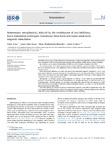Homeostatic metaplasticity induced by the combination of two inhibitory brain stimulation techniques: continuous theta burst and transcranial static magnetic stimulation

Ver/Abrir
Use este enlace para citar
http://hdl.handle.net/2183/38389
Excepto si se señala otra cosa, la licencia del ítem se describe como Creative Commons Attribution-NonCommercial-NoDerivs 4.0 International License (CC-BY-NC-ND 4.0)
Colecciones
- Investigación (FCS) [1295]
Metadatos
Mostrar el registro completo del ítemTítulo
Homeostatic metaplasticity induced by the combination of two inhibitory brain stimulation techniques: continuous theta burst and transcranial static magnetic stimulationFecha
2024-07-15Cita bibliográfica
Arias P, Adán-Arcay L, Madinabeitia-Mancebo E, Cudeiro J. Homeostatic metaplasticity induced by the combination of two inhibitory brain stimulation techniques: continuous theta burst and transcranial static magnetic stimulation. Neuroscience. 2024 Jul 15;554:128-136.
Resumen
[Abstract] Aftereffects of non-invasive brain stimulation techniques may be brain state-dependent. Either continuous theta-burst stimulation (cTBS) as transcranial static magnetic field stimulation (tSMS) reduce cortical excitability. Our objective was to explore the aftereffects of tSMS on a M1 previously stimulated with cTBS. The interaction effect of two inhibitory protocols on cortical excitability was tested on healthy volunteers (n = 20), in two different sessions. A first application cTBS was followed by real-tSMS in one session, or sham-tSMS in the other session. When intracortical inhibition was tested with paired-pulse transcranial magnetic stimulation, LICI (ie., long intracortical inhibition) increased, although the unconditioned motor-evoked potential (MEP) remained stable. These effects were observed in the whole sample of participants regardless of the type of static magnetic field stimulation (real or sham) applied after cTBS. Subsequently, we defined a group of good-responders to cTBS (n = 9) on whom the unconditioned MEP amplitude reduced after cTBS and found that application of real-tSMS (subsequent to cTBS) increased the unconditioned MEP. This MEP increase was not found when sham-tSMS followed cTBS. The interaction of tSMS with cTBS seems not to take place at inhibitory cortical interneurons tested by LICI, since LICI was not differently affected after real and sham tSMS. Our results indicate the existence of a process of homeostatic plasticity when tSMS is applied after cTBS. This work suggests that tSMS aftereffects arise at the synaptic level and supports further investigation into tSMS as a useful tool to restore pathological conditions with altered cortical excitability.
Palabras clave
Homeostatic plasticity
Human
Non-invasive brain stimulation
Theta-burst stimulation
Transcranial magnetic stimulation
Transcranial static magnetic field
Human
Non-invasive brain stimulation
Theta-burst stimulation
Transcranial magnetic stimulation
Transcranial static magnetic field
Versión del editor
Derechos
Creative Commons Attribution-NonCommercial-NoDerivs 4.0 International License (CC-BY-NC-ND 4.0)
ISSN
0306-4522
Ítems relacionados
Mostrando ítems relacionados por Título, autor o materia.
-
Variability in non-invasive brain stimulation studies: Reasons and results
López-Alonso, Virginia; Guerra, Andrea; Cheeran, Binith; Suppa, Antonio (Elsevier, 2020-02-06)[Abstract]: Introduction: Non-invasive brain stimulation techniques (NIBS), such as Theta Burst Stimulation (TBS), Paired Associative Stimulation (PAS) and transcranial Direct Current Stimulation (tDCS), are widely used ... -
Solutions for managing variability in non-invasive brain stimulation studies
López-Alonso, Virginia; Guerra, Andrea; Cheeran, Binith; Suppa, Antonio (Elsevier, 2020-02-06)[Abstract] Introduction: In the last three decades, a number of non-invasive brain stimulation (NIBS) protocols, capable of assessing and modulating plasticity in the human motor cortex (M1), have been described. For ... -
A preliminary comparison of motor learning across different non-invasive brain stimulation paradigms shows no consistent modulations
López-Alonso, Virginia; Fernández-del-Olmo, Miguel; Cheeran, Binith; Sandrini, Marco; Abe, Mitsunari; Cohen, Leonardo; Liew, Sook Lei (Fronteirs, 2018-04-23)[Abstract]: Non-invasive brain stimulation (NIBS) has been widely explored as a way to safely modulate brain activity and alter human performance for nearly three decades. Research using NIBS has grown exponentially ...






